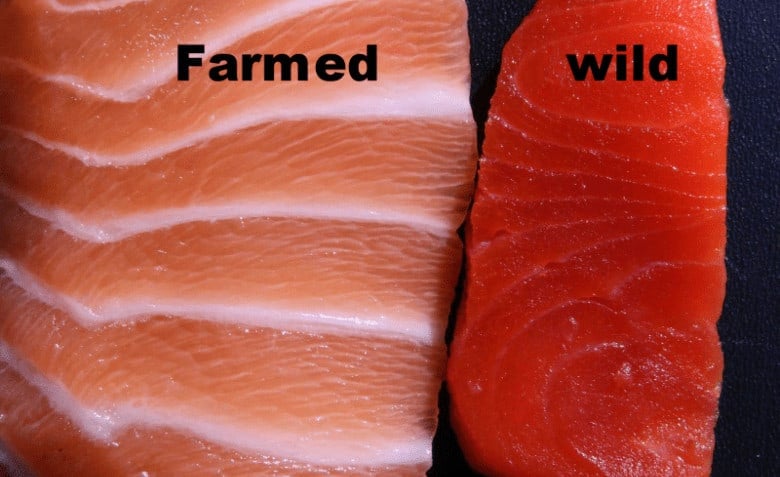Salmon is a delicious and nutritious seafood option, but when it comes to choosing between farm-raised and wild-caught, there’s more to consider than taste.
This debate about Farm Raised vs Wild Caught Salmon hinges on two key factors: environmental impact and flavor profile. In this exploration, we’ll explore both sides of the coin, helping you make an informed decision about the salmon you choose.
Farm-Raised vs. Wild-Caught Salmon: A Seafood Showdown

Seafood lovers and environmentalists alike often find themselves debating the merits of farm-raised versus wild-caught salmon. These two types of salmon offer distinct advantages and disadvantages, impacting both your health and the environment.
Farm-raised salmon are bred and raised in controlled fish farms. Wild-caught salmon, as the name suggests, are caught in their natural habitats, like rivers and oceans. The rise of farm-raised salmon is a response to the growing demand for this popular fish and the concerning decline of wild salmon populations due to overfishing and environmental factors. Consumers often wonder which option is healthier, more sustainable, and tastier.
This comparison aims to illuminate the environmental impact and taste differences between farm-raised and wild-caught salmon. By exploring the farming practices, environmental footprint, and taste profiles of both options, you’ll be empowered to make informed decisions that align with your values and preferences. Whether you prioritize sustainability, nutrition, or flavor, a deeper understanding of these two salmon types will guide you toward the perfect choice.
The Environmental Impact of Salmon: Farmed vs. Wild

Raising salmon on farms can have negative consequences for the environment. Here’s why:
- Water Pollution: Waste products and uneaten food from salmon farms pollute the water. This disrupts the delicate balance of the ecosystem.
- Chemical Use: Antibiotics and other chemicals used in fish feed and treatments can harm the surrounding environment.
- Disease Risk: The proximity of farmed salmon increases the risk of diseases spreading to wild fish populations.
A Sustainable Choice: Wild-Caught Salmon
Wild-caught salmon generally have a lower environmental impact compared to farmed salmon. Here’s how:
- Sustainable Fishing: Techniques like hook-and-line or gillnet fishing minimize damage to the ecosystem.
- Natural Diet: Wild salmon feed on natural food sources, reducing pollution from excess feed and waste.
- Habitat Preservation: Supporting sustainable fishing helps preserve natural habitats and maintain healthy wild salmon populations, minimizing their overall environmental impact.
By choosing wild-caught salmon, you can support sustainable fishing practices that contribute to the health and balance of our oceans.
Farm-Raised Salmon: A Convenient Choice, But With Trade-offs
Farm-raised salmon is a popular seafood option, but it comes with its own set of considerations. Here’s a breakdown:
What is Farm-Raised Salmon?
Farm-raised salmon are bred and raised in controlled aquatic environments like fish farms. These farms house the fish using various methods, such as ponds, tanks, or net pens. Their diet typically consists of specially formulated pellets containing fish meal, fish oil, and other ingredients.
While raising salmon in controlled environments offers advantages like consistent supply, several concerns surround these practices.
- Antibiotic Use: Antibiotics are sometimes used to prevent diseases in these high-density environments.
- Disease Transmission: Close quarters can increase the risk of disease spreading among the fish.
- Environmental Impact: Excess feed and fish waste can pollute surrounding waters.
Taste and Texture
Farm-raised salmon generally has a milder flavor and a more buttery, tender texture compared to wild-caught salmon. The higher fat content and thicker fillets make them less prone to overcooking, which can be ideal for new cooks. Additionally, farm-raised salmon raised in saltwater can be certified parasite-free, allowing for safe consumption raw or undercooked. However, some consumers miss the stronger, “fishy” taste found in wild salmon.
Wild-Caught Salmon: A Taste of Nature’s Bounty
Wild-caught salmon live and thrive in their natural habitats—oceans, rivers, and lakes. Unlike their farm-raised counterparts, they rely on natural ecosystems for food and follow their instinctive feeding patterns. Fishermen employ various techniques to catch wild salmon, including trolling, gillnetting, and seining.
Wild-caught salmon is renowned for its robust and flavorful profile. Seafood enthusiasts appreciate its distinct “fishy” taste, a characteristic directly linked to the salmon’s natural diet and active lifestyle. This diet, rich in krill and other marine organisms, contributes to the salmon’s vibrant color and firm texture.
Fishing Methods: Balancing Sustainability and Efficiency
The harvesting of wild-caught salmon depends on location and species. Trolling, a popular method, involves fishermen trailing multiple baited hooks to attract salmon. This targeted approach minimizes bycatch, the accidental capture of unintended marine life. Gillnetting utilizes large nets set in the water to trap fish. While effective for catching large quantities, this method can have a higher bycatch rate. Seining employs a vast net to surround and capture entire schools of salmon. All these methods are carefully regulated to ensure sustainable salmon populations and minimize environmental impact.
A Superior Taste Experience
Many consider wild-caught salmon to have a far superior taste compared to farm-raised varieties. The natural environment and diet of wild salmon contribute to its richer, more robust flavor. The krill and other organisms in their diet impart a distinct and pronounced taste. Additionally, the exercise wild salmon get from their free-roaming lifestyle results in firmer and more tender flesh. While flavor can vary slightly depending on the species and region, wild-caught salmon offers a more authentic and satisfying taste experience overall.
Farm-Raised vs. Wild-Caught Salmon: A Choice Between Taste and Sustainability
When it comes to salmon, you have two main options: farm-raised or wild-caught. Each comes with its own set of pros and cons, making the decision a bit more complex than just picking your favorite fish.
Environmental Impact:
- Farm-raised: Often criticized for its negative environmental effects. Pollution from fish waste and uneaten food can harm surrounding ecosystems. Additionally, antibiotics used in fish farms can contribute to antibiotic resistance.
- Wild-caught: This is considered a more sustainable option as it doesn’t involve altering the natural environment. However, overfishing can be a concern depending on the specific species and location.
Taste:
- Farm-raised: This type generally has a milder flavor due to its controlled diet of fish pellets. The fat content can also be higher, making it a richer texture.
- Wild-caught: Its natural diet consists of smaller fish and other marine life, which gives it a stronger, more distinct flavor. The flesh tends to be firmer and slightly less fatty than farm-raised.
You can also consider a balanced approach. Look for certifications that indicate sustainable fishing practices for wild-caught salmon. Additionally, incorporating both farm-raised and wild-caught salmon into your diet allows you to enjoy the taste benefits of both while minimizing your environmental impact.
Conclusion
This analysis highlights the trade-offs between farm-raised and wild-caught salmon. While farm-raised salmon might be readily available and potentially milder in taste, its environmental impact due to farming practices can be significant. On the other hand, wild-caught salmon is generally considered more sustainable but may come with a slightly higher price tag and a stronger flavor.
The best choice depends on your priorities. If environmental consciousness is your top concern, wild-caught salmon is the way to go. If taste is your main focus, consider your preference: a richer flavor (wild-caught) or a milder option (farm-raised). Additionally, factor in any health concerns you have about contaminants, as wild-caught salmon typically contains lower levels. By weighing these factors, you can make an informed and responsible decision when selecting your salmon.
References:
FAQ About Farm Raised Vs Wild Caught Salmon: Comparing Environmental Impact And Taste
Q: What are the differences between farm-raised and wild-caught salmon in terms of environmental impact?
A: Farm-raised salmon can have a higher environmental impact due to issues such as waste pollution, disease outbreaks, and habitat destruction, whereas wild-caught salmon is more often considered a sustainable option with less negative impact on the environment.
Q: How do the tastes of farm-raised and wild-caught salmon differ?
A: The taste of salmon can be influenced by various factors such as diet, environment, and fat content. Generally, wild-caught salmon is believed to have a more distinct and robust flavor due to its natural diet and lifestyle, while farm-raised salmon may have a milder taste.
Q: Which type of salmon is more nutritious – farm-raised or wild-caught?
A: Wild-caught salmon is often considered to be more nutritious than farm-raised salmon due to its natural diet and higher levels of omega-3 fatty acids. However, both types can be healthy sources of protein and essential nutrients.
Q: Are there any concerns regarding sustainability when choosing between farm-raised and wild-caught salmon?
A: Yes, sustainability is a key consideration when choosing between farm-raised and wild-caught salmon. Farm-raised salmon production can often lead to issues of overfishing, habitat degradation, and dependence on wild fish for feed. In contrast, wild-caught salmon from well-managed fisheries can be a more sustainable choice.
Q: How can consumers make an informed choice between farm-raised and wild-caught salmon?
A: When choosing between farm-raised and wild-caught salmon, consumers can consider factors such as environmental impact, taste preferences, nutritional content, and sustainability certifications. It is also helpful to research the source of the salmon and make informed decisions based on personal values and priorities.

Welcome to Braddock Bay Tavern & Grill, where history, delicious cuisine, and stunning views come together to create an unforgettable experience. Our restaurant, situated on the picturesque edge of Lake Ontario, has a rich history that adds a unique charm to your dining experience. The roots of our establishment can be traced back to 1865, when it was first constructed as an icehouse. Over the years, it transformed into the historic Braddock Bay Hotel, becoming a beloved local landmark. Today, we take pride in preserving the building’s historical beauty, ensuring that every visit to our restaurant is a journey through time.
